Introduction
When the System Buyers Guide: $1000 to $2000 was published a few weeks ago it was obvious the last system guide in the series should be the High End Buyers Guides for systems above $2000. It was our full intention at that point to present both AMD and Intel systems for our High-End Buyers Guide, but an AnandTech meeting with all the editors quickly changed that idea. It was the consensus that as of today there is only one CPU at the top of the performance heap, and that CPU is the Intel Core i7.
With the introduction of the Phenom II, AMD now has a legitimate competitor to Intel Core 2 Duo and Core 2 Quad systems. The recent price cuts by both Intel and AMD in that market segment just reinforced the fact that Phenom II competes very well with Intel Penryn. Perhaps with higher speeds Phenom II processors might make the High-End Buyers Guide in the future, but as of today the Intel Core i7 owns the high-end of the CPU market.
With that reality in mind, it seemed almost pointless to publish a high-end system guide that just presented a dream Core i7 system. It is also clear to us that, despite the fact that Phenom II does not compete well at the very top, it is still a significant achievement for AMD and the processor market, and it deserves better than to be ignored.
Therefore you will see two specialty guides in the next few weeks. This guide will concentrate on Intel Core i7 systems. After some announcements by AMD, we will also be posting a guide for Phenom II systems. While Core i7 and Phenom II now cover different market segments and different price points, they both are significant CPUs in their own right and both deserve a spotlight on CPU compatibility and getting the most from each CPU. Core i7 and Phenom II are where the action and interest are in today's computer market, and the guides will try to provide help in selecting components for your new Core i7 or Phenom II system.
This Core i7 Buyers Guide looks at three different i7 builds that you might consider. The Core i7 is high on the performance tree but it is also expensive compared to other solutions. Not everyone can afford the $2000 Core i7 system presented in the $1000 to $2000 Buyers Guide. For builders who want an i7 system for as little money as possible we put together a Core i7 Entry system. The goal is simple: build a competent i7 system for as little money as possible. We managed to cut more that 25% from our last Core i7 system price without significant compromises.
Another typical buyer is attracted to the Core i7 because of the tremendous overclocking potential of the processor. As seen in Overclocking Core i7 and other Core i7 articles, the 2.66GHz 920 can reach 3.6GHz to 4GHz with proper air cooling. That is faster than the stock speed available even with the $1000 Core i7 965. The goal of the Core i7 Overclocking System build is a system that provides the flexibility and components to maximize overclocking. The slant is to the value end of overclocking - overclocking to increase value - rather than the absolute highest performance options. However, we do make some recommendations for those who overclock strictly for performance.
Finally, there is the Core i7 High-End System. The goal is to select the best performing components available, and not just the most expensive. The very high end of any system in the computer industry will rarely yield the best bang for the buck. Squeezing the last bit of performance from a component usually means spending a great deal more money than buying the component that delivers the best performance for the dollar. However, luxury and top performance sell well, and these components are still the stuff that computer dreams are made of. Our Dream Core i7 system reaches around $5000, and frankly we could have extended the cost much further by expanding storage and selecting a RAID 5 controller and drive array. Still, the components in the High-End Guide should be food for thought as you select your own Core i7 System.
Core i7 Entry
With the i7 processors at the top of every performance comparison, many readers are interested in building a new Core i7 system. However, much of the i7 architecture is unique compared to current computer architectures, with a new socket 1366 and triple-channel DDR3 memory. That means i7 buyers will likely be buying more components than normal for the move to i7. In fact it is not unreasonable to expect a complete new system build, or at least the bulk of a complete system build, when you decide to move up to Core i7.
The question then is what is the absolute minimum you can spend and still get into a decent performing i7 system? In our System Buyers Guide: $1000 to $2000 a balanced i7 system with the cheapest Core i7 CPU managed to squeeze in at just under $2000. In the short time since that guide was published many prices have dropped, new drivers are available, and there are more options available for a Core i7 system. The goal is also a bit more modest in this Core i7 Entry system. The task was to put together a complete i7 system at near bare bones pricing.
In almost every category a lower performing and lower priced option is possible, but it makes little sense to build an i7 system and saddle it with last generation's midrange video card for example. For that reason the video choice was a Radeon 4870 1GB, which many consider the minimum for a serious gaming rig. Where the lower-priced options make just a small difference in performance we chose lower price, but where it really mattered in total system performance the better performing choice was made.
| Core i7 Entry PC | ||
| Hardware | Component | Price |
| Processor | Intel Core i7 920 Socket 1366 (2.66GHz Quad-core, 4x256KB L2, 8MB L3 Cache) | $295 |
| Cooling | Intel Retail HSF | - |
| Video | MSI R4870-T2D1G Radeon HD 4870 1GB | $205 |
| Motherboard | GIGABYTE GA-EX58-UD3R X58 | $185 |
| Memory | Patriot Viper 3GB (3x1GB) DDR3-1333 (PC3-10666) PVT33G1333ELK - Retail | $70 |
| Hard Drive | Samsung Spinpoint F1 HD103UJ 1TB | $95 |
| Optical Drive | LG BD/HD DVD / 16x DVD+/- RW GGC-H20LK | $105 |
| Audio | On-Board Audio | - |
| Case | COOLER MASTER Centurion 534 RC-534-SKN2-GP ATX Mid-Tower | $50 |
| Power Supply | OCZ StealthXStream OCZ700SXS 700W SLI Ready CrossFire Ready | $70 |
| Display | Acer H213Hbmid 21.5" 5ms HDMI 1080P LCD - Retail | $190 |
| Speakers | Creative Inspire T6100 76W 5.1 Speakers | $70 |
| Input | Microsoft CA9-00001 Black PS/2 Keyboard and Optical USB/PS2 Mouse - OEM | $16 |
| Operating System | Microsoft Vista Home Premium OEM | $99 |
| Bottom Line | $1450 | |
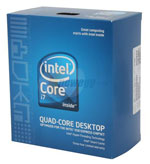 |
The i7 920 is the lowest priced Intel Core i7 you can currently buy. The other two choices are in the $600 to $1000 price range. Don't assume, however, that the 920 is not a powerful processor. The i7 920 is 30% faster in some tests than a Core 2 Quad, and then you find you can also overclock this 2.66GHz CPU to 3.6GHz to 4GHz with careful tweaking and better cooling. You will certainly be very happy with Core i7 base performance, but if you are interested in overclocking you will be even happier with this new CPU.
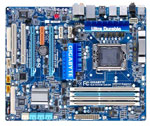 |
The Gigabyte GA-EX58-UD3R has the distinction of being the lowest priced X58 chipset motherboard you can currently buy. Others will join that sub-$200 price point soon to provide more X58 value choices. You probably also noticed that Gigabyte is trying to get as much mileage as possible from their UD3R designation, holding on to a good name as much as possible.
Since this system goal is the lowest priced Core i7 system, we stuck with the retail Intel HSF that comes with the CPU. It works fine with the Core i7 at stock speeds, even though it runs hotter than a similar Intel HSF on Core 2 chips. In the past an Intel retail HSF would be a guarantee of at least midrange overclocking, but the Core i7 runs hotter and you will not get much of an overclock with the Intel HSF. If you plan to overclock you will definitely need a third party HSF, like the Vigor Monsoon III or the Thermalright Ultra-120 eXtreme-1366.
In the Core i7 System in the $1000 to $2000 System Guide, the problems with ATI drivers on Core i7 were discussed. Since then driver releases from ATI are going in the right direction. There is also the price difference, with the capable 4870 1GB some $120 less than the now lower-priced NVIDIA GTX 280. There is also the fact that the Gigabyte GA-EX58-UD3R supports only CrossFire for multiple GPUs.
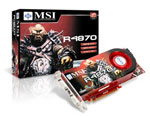 |
Put all those pieces together and the choice for GPU on the i7 Entry system is the Radeon 4870 1 GB. The best value today is the MSI R4870-T2D1G, which is just $205 after a $25 rebate. The best value in HD 4870 1GB cards shifts day-by-day, but you can generally shop for the lowest price on a 4870 1GB card and end up with a good quality card.
 |
Triple-channel memory comes in a 3GB kit (3x1GB) or a 6GB kit (3x2GB). Value dictates the 3GB choice with a great memory package from Patriot. The Viper DDR3-1333 comes as a 3GB kit won't break the bank at $70. For just $70 more, you can upgrade to a 6GB DDR3-1333 kit instead.
Good cases and power supplies are either used forever or they go with the old board on a system upgrade. Generally, it's best to invest in the best case and power supply you can afford. Since this is an Entry i7 we can cut costs on the case and PSU, and with numerous price cuts and rebates available on these components you can still get a lot of value for just a little money.
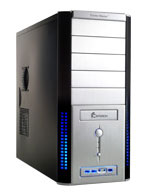 |
The Cooler Master Centurion 534 is a good value no matter how you look at it. It does come in different configurations, and the RC-534-SKN2-GP case is a good choice since it comes with three 120mm fans (front, side, and back) for cooling and installation requires no tools other than a screwdriver for mounting the motherboard. There are also plenty of drive bay options with five external 5.25" bays, one external 3.5", and four internal 3.5". Front USB/Firewire/Audio connectors are also featured. Builders report smooth edges and no sharp pieces to cut your hand during assembly. Even the expansion slots are screwless in this design. Our selection at $50 is black with a brushed aluminum and mesh front, but the case is also available in all black if you prefer at $55.
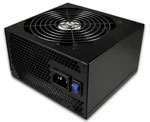 |
The power supply is an excellent value at $70. That $70 buys a 700W OCZ StealthXStream after a $20 rebate. This OCZ PSU specifies an efficiency of greater than 85% with both overload and overvoltage protection. The OCZ StealthXStream 700W should be able to handle whatever you ask of it in powering or overclocking a more basic Core i7 920 system.
 |
Hard drive capacity continues to grow, as you can see in our selection of the Samsung SpinPoint 1TB (1000GB) hard drive at just $95. For less than $100 the value is incredible. While there are differences between hard drives, outside of running benchmarks most people aren't likely to notice the difference in performance between Western Digital, Seagate, Samsung, Hitachi, and other major brands. All are worthy of consideration if the price per gigabyte (or terabyte) is right.
 |
The optical drive for an entry Core i7 system needs to play Blu-ray disks. The flexible LG GGC-H20LK has the ability to read both Blu-ray and HD-DVD format disks. It also can burn DVDs at 16x speed in single or dual-layer formats. It cannot, however, burn 25GB/50GB Blu-ray disks; adding that capability raises the cost to around $200. A BD burner like the LG 6X Blu-ray Burner GGW-H20LK is a good choice if you require a Blu-ray burner.
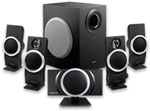 |
After reviewing the current state of onboard audio, we concluded that the onboard solutions are plenty adequate for most of today's computer users. That is why we stuck with the onboard audio on the Gigabyte. Speakers are the 5.1 Creative Inspire T6100 76W system. At $70 the T6100 delivers very good 5.1 surround sound for the price.
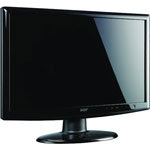 |
The LCD display resolution for the Entry Core i7 system is 1080p full HD (1920x1080). The monitor is one of the new class of 21.5" monitors with a resolution the same as last generation's 24" LCD monitors. The newest monitors use a 16:9 "true HD" ratio instead of last generation's 16:10. The resolution is the same as 24" monitors, but the price is a bargain at $190, which saves at least $100. The Acer H213Hbmid monitor is rated at 5ms and features HDMI inputs for easy hookup to the latest video cards like the MSI Radeon 4870 1GB used in this entry Core i7 system.
By paring components to the items that most affected performance, the bottom line price for a complete Core i7 is cut by more than 25% from our choices of just a few weeks ago. This reduces the price of entry for a complete i7 system to $1450 including a 1080p LCD Monitor, keyboard/mouse, 5.1 speakers, Blu-ray player, 1TB drive, Radeon 4870 1GB graphics, and Windows Vista OS. Performance of this i7 Entry system is definitely in the high-end class, although we will be extending that performance even further in our builds of the Core i7 Overclocking System, and Core i7 Dream system.
Core i7 Overclocking
One of the great attractions of the Intel Core i7 is its fantastic overclocking ability. As shown in Overclocking Core i7, the overclocking ability varies by CPU and the chip's onboard memory controller. Still, overclocks of the 2.66GHz 920 chip normally can reach 3.6GHz to 4.0GHz with air-cooling - and even higher with water- and phase-change-cooling.
As discussed in many overclocking articles here, there are normally two types of overclockers. First are those who overclock for value, which are those that select cheaper parts rated at lower specs for their ability to overclock to much higher performance levels. Second, there are overclockers who try to reach the highest overclock possible, and who usually choose the highest priced and higher-performance parts to overclock even further. This Core i7 Overclocking System leans toward the value side of the overclocking equation. Generally parts were selected, like the Core i7 920, because they are a good value that becomes an outstanding value when overclocked. Where an alternative exists that would be a better choice for the "absolute" overclocker it will be pointed out.
| Intel Core i7 Overclocking PC | ||
| Hardware | Component | Price |
| Processor | Intel Core i7 920 Socket 1366 (2.66GHz Quad-core, 4x256KB L2, 8MB L3 Cache) | $295 |
| Cooling | Thermalright Ultra-120 eXtreme-1366 RT | $75 |
| Video | MSI R4870-T2D1G Radeon HD 4870 1GB | $205 |
| Motherboard | DFI LP UT X58-T3eH8 X58 - Retail | $300 |
| Memory | Kingston HyperX T1 3GB (3x1GB) DDR3-1866 (PC3-14900) Kit KHX14900D3T1K3/3GXR | $159 |
| Hard Drive | Seagate Barracuda 7200.11 ST31000333AS 1TB | $105 |
| Optical Drive | LG 6X BD-R 2X BD-RE 16X DVD+R 6X Blu-ray DVD-ROM SATA Blu-ray Burner GGW-H20LK | $190 |
| Audio | On Board | - |
| Case | Antec Nine Hundred Black Steel ATX Mid Tower | $100 |
| Power Supply | CORSAIR CMPSU-850TX 850W SLI Ready CrossFire Ready 80+ Certified | $130 |
| Display | ASUS VW246H Black 24" 2ms (GTG) HDMI 1080P | $290 |
| Speakers | Logitech G51 155W RMS 5.1 Speakers - Retail | $90 |
| Keyboard | Logitech G11 USB Gaming Keyboard | $59 |
| Mouse | Logitech MX518 8-Button/1 Wheel USB 1800dpi Laser Mouse | $40 |
| Operating System | Microsoft Vista Home Premium OEM | $99 |
| Bottom Line | $2137 | |
 |
The i7 920 is the lowest priced Intel Core i7 you can currently buy. It is normally the choice for overclockers because it can reach as high as 4.0GHz with air-cooling if you are lucky enough to find one with a strong on-chip memory controller. Even those that don't reach the top normally make it to 3.6GHz without too much effort. That represents a huge performance boost for an entry-level part - even a high-end "entry" CPU.
In our look at overclocking in the Phenom II Launch review, the Core i7 920 reached as high as 3.8GHz at stock voltage and 4.0 GHz when overvolted to 1.35V. That is a 50% overclock. You start with a processor that is 30% faster in some tests compared to a Core 2 or Phenom II, and then you find you can also overclock this 2.66GHz CPU to 3.8GHz to 4GHz with careful tweaking and better cooling. You will certainly be very happy with Core i7 base performance, but in overclocking you will be ecstatic with this CPU.
The one drawback of the 920 is the locked 20X multiplier. Overclocking can only be achieved by increasing the "bus" speed (there really is no "bus speed" in the i7 design). The only Core i7 with an unlocked multiplier is the Core i7 965. That processor is an excellent choice if you prefer the multiplier route to overclocking or if you want the multiplier available as one of the variable OC parameters. However, be prepared for a significant increase in price. The Core i7 965 street price is around $1000.
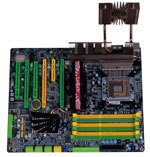 |
The DFI LP UT X58-T3eH8 LGA 1366 is the best overclocking socket 1366 motherboard we have tested so far. DFI is a motherboard name with a long history of overclocking champions, and the new LAN Party UT X58 will not disappoint. Recent DFI boards have been some of the best overclocking designs we have seen from DFI. The company hired some engineers from the old Abit and their influence is certainly seen in recent designs. The DFI X58-T3eH8 is also compatible with either CrossFire or SLI, which provides great flexibility in selecting a GPU. The entry i7 Gigabyte GA-EX58-UD3R is a superb motherboard, but it is CrossFire only. That is not really an issue if you select an AMD video card, but it does somewhat limit choices for future expansion. With both CrossFire and SLI compatibility, the DFI can go wherever the GPU market leads and still support future expansion to multiple GPUs.
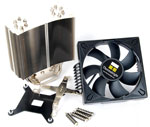 |
Several well-known coolers offer optional adapters for socket 1366, but the cooler choice to mate with the DFI X58 board for overclocking is the Thermalright Ultra-120 eXtreme-1366 RT. This is basically the top performing Thermalright Ultra-120 eXtreme from our Core 2 tests combined with a socket 1366 adapter and an included quiet high-performance 120mm fan. There are several socket 1366 coolers in the lab for testing and we will have more to say about their performance in the next few weeks. The Thermalright socket 1366 is a good choice for Core i7 overclocking.
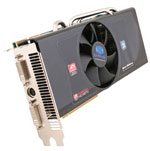 |
It is very difficult to recommend an NVIDIA GTX 285, or even the GTX 280, when the similar performing Radeon 4870 1GB is available for $135 less at $205. Our choice for the GPU is the MSI R4870-T2D1G Radeon HD 4870 1GB, which is the same card used in our Core i7 Entry System. The NVIDIA GTX 280 and GTX 285 are excellent alternatives if you can handle the 50% higher price or if the prices drop. We actually still prefer the performance of the NVIDIA cards on Core i7, but the price difference is hard to swallow.
Memory for overclocking the Core i7 needs to have a very wide operating range to keep up with the higher "bus" speeds needed to overclock the i7 920. The highest speed production memory you can currently buy, with performance warranted at rated speed, are the DDR3-2000 3GB kits. Right now the 3GB memory kits are also better at the higher speeds than 6GB triple-channel kits. That will be changing soon, however, as higher speed 6GB kits are starting to make their way to market.
 |
Our selection is close to the highest speed available with the top-performing Kingston HyperX T1 3GB (3x1GB) DDR3-1866 (PC3-14900) triple channel kit. You are guaranteed a latitude to DDR3-1866 above the normal speed of DDR3-1333. You can also dial down the base speed to 1066 to squeeze even more range from the memory. Kingston normally rates their HyperX memory conservatively and it is likely to perform even better than rated. If you want the fastest 3GB kit you can buy you can choose the 3GB DDR3-2000 kit from G.Skill or the hard to find DDR3-2000 kit produced by Kingston. The Mushkin DDR3-1600 kit used in the Dream i7 system is also a good choice because of the very fast rated timings of 7-8-7 at DDR3-1600 in a 6GB memory kit instead of the 3GB we chose for this i7 OC system.
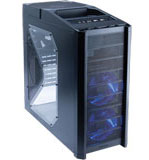 |
The case receives an upgrade with the selection of the well-regarded Antec Nine Hundred which bottom mounts the power supply and provides plenty of internal storage. Cooling is provided by 120mm fans and a massive 200mm top exhaust fan. The Nine Hundred is a great choice for an overclocking case that will use air-cooling. There is also the upgrade Nine Hundred Two for about $50 more.
 |
An overclocking power supply for the Core i7 needs plenty of reserve power provided by a conservative design with solid build quality. The 850W Corsair CMPSU-850TX should be able to handle whatever you want to do with this i7 system. It is 80 Plus certified and provides 12V power on a single rail. There is also the fact that Corsair has a reputation for conservatively rating their power supplies, which means this 850W should be as good as many other 1000W power supplies. That makes the 850TX a great value at just $140 after rebate.
An SSD (Solid State Drive) would be a great addition for a boot drive and/or game drive in this Core i7 OC system. The problem is we don't yet know which SSD to recommend. AnandTech is in the process of testing the latest generation of cheaper SATA II designs, but until this is complete it would be impossible to recommend any SSD other than the expensive Intel 80GB and 160GB SSDs. In our previous tests, the earlier SSDs were plagued with data corruption issues as the drive neared capacity and with annoying random pauses that were particularly troublesome in gaming. Anand is in the process as this goes to press of evaluating new SSDs for an upcoming review. Be sure to look for his SSD roundup and recommendations for an SSD. I have been using a very reasonable G.Skill 64GB SATA II SSD with good results for several weeks. The SSD is just $129 and the entire Windows 7 beta system with all drivers occupies just 30GB of the 64GB available. My subjective experience has been good, but this is one of the drives included in the SSD roundup where it will be tested in a more systematic manner.
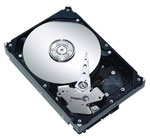 |
Our storage drive selection for the Core i7 Overclocking system is the Seagate Barracuda 1TB drive (1000GB). While the Seagate 1.5TB drive and the early 1.0TB drive were plagued with firmware problems at their release, the performance and reliability of this later 1TB Seagate has been excellent in our testing so far. For a price of around $100 the value is incredible. While there are differences between hard drives, outside of running benchmarks most people aren't likely to notice the difference in performance between Western Digital, Seagate, Samsung, Hitachi, and other major brands. All are worthy of consideration if the price per gigabyte (or terabyte) is right.
 |
We feel the optical drive for the Core i7 OC system needs to both play Blu-ray disks and burn 25GB/50GB Blu-ray discs. We have upgraded the optical drive to the flexible LG GGW-H20LK burner, which is now selling for just $190 and has the ability to both read and write Blu-ray disks. It also can burn DVDs at 16x speed in single or dual-layer formats.
The onboard audio solution is adequate for most of today's computer users. That is why we stuck with the onboard audio on the DFI. This also removes one more overclocking variable in that it is easy to turn off onboard audio if for some reason it becomes an impediment to overclocking. If you are heavily invested in game titles that do best on a Sound Blaster card, you might consider a Creative Labs sound card. If you gravitate toward audiophile quality, the ASUS Xonar 1.1 is a good upgrade.
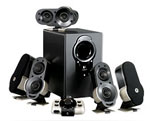 |
Speakers have been upgraded to the Logitech G51 155W RMS 5.1 surround sound speakers. They are selling for $90 after a $40 rebate, which is a great value on these well-regarded powered speakers.
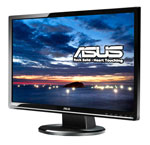 |
The LCD display resolution is the same 1080p HD resolution chosen for the value midrange systems; the size of the monitor however is increased to 24" so everything on screen is just a little larger. The ASUS VW246H 24" 2ms (GTG) HDMI provides the preferred DVI and HDMI inputs, as well as an analog VGA port. Panel speed is rated at 2ms, but we have found most current LCD panels perform similarly and the speed rating does not really guarantee very much. The ASUS monitor provides a sharp image, good colors, and fast panel speed at a very good price of $290. For more information on what matters in a monitor and how to read LCD specifications take a look at our Holiday 2008 Display Guide.
It is worth pointing out that all the LCD monitors from the new class of 21.5" full 1080p to the large 28" monitors all feature resolutions of 1920x1200 or 1920x1080. Older 22" monitors are 1680x1050. The point here is that for higher resolution - higher than 1920 horizontal resolution that is - the next step in monitors is the 30" 2560x1600 displays. Moving up to a 26"-28" LCD gives bigger pixels, not a higher resolution. (Yes, there are also a few 23" LCDs with a slightly higher 16:9 resolution, like the Dell SP2309w, but 2048x1152 isn't a huge step up.) Also note that nearly all new 21" to 28" LCDs are using TN panels instead of S-PVA or S-IPS, particularly the inexpensive options. There's a reason some 24" LCDs still cost over $500.
The Bottom Line for the Core i7 Overclocking System is $2137 for the complete system. We are confident that with a little effort you can overclock this system to 3.6GHz to 4.0GHz on air-cooling. Of course, we could never guarantee that result as components do vary in their capabilities, but you should have every expectation that this Core i7 OC System can easily perform at levels higher than the $1010 Core i7 965, which is specified at 3.2GHz.
Core i7 Dream System
We're calling the Core i7 High-End system our "Dream" system - and for many in the current economic times, that's exactly what this is: a dream. Components were selected because they represent the highest end of the performance curve with some tilt toward value. That does not mean the components of the Core i7 Dream System are the best value or the best bang for the buck, as in most cases you pay a lot at the top for a fairly small increase in performance. However, in most cases the component selected is a top performer.
This is not no-holds-barred, as we could easily have chosen a RAID 5 storage setup with 1TB to 2TB enterprise drives and an SSD RAID boot array. We stopped short of choosing that option, but some will be interested in going that direction. As the dollars added up quickly the final decision was to limit the high-end to somewhere around $5000. More can be spent, and if you're looking at the deficiencies in this $5000 Core i7 system you certainly know where you would like to spend the extra dollars. In the end the i7 Dream is a heck of a system, as we hope you will agree.
| Intel i7 Dream System | ||
| Hardware | Component | Price |
| Processor | Intel Core i7 965 Socket 1366 (3.2GHz Quad-core, 4x256KB L2, 8MB L3 Cache) | $1010 |
| Cooling | Vigor Monsoon III LT for Socket 1366 | $60 |
| Video | EVGA 017-P3-1291-AR GeForce GTX 295 2.0 x16 | $505 |
| Motherboard | ASUS P6T6 WS Revolution X58 | $370 |
| Memory | Mushkin 6GB (3x2GB) DDR3-1600 (PC3-12800) 7-8-7-20 Kit 998679 | $205 |
| SSD | Intel X-25M SSDSA2MH160G1C5 160GB | ($729) |
| Hard Drive | Western Digital Caviar Black WD1001FALS 1TB 7200 RPM 32MB Cache SATA 3.0Gb/s | $120 |
| Optical Drive | LG 6X BD-R 2X BD-RE 16X DVD+R 6X Blu-ray SATA Blu-ray Burner GGW-H20LK | $190 |
| Optical Drive | LG BD/HD DVD / 16x DVD+/- RW GGC-H20LK | $110 |
| Audio | ASUS Xonar DX 7.1 | $90 |
| Case | Silversone FT01-BW Aluminum ATX Mid-Tower Unibody | $230 |
| Power Supply | CORSAIR CMPSU-1000HX 1000W SLI Ready CrossFire Ready 80 PLUS Certified Modular | $210 |
| Display | LG W3000H-Bn 30" 2560x1600 5ms S-IPS LCD | $1100 |
| Speakers | Logitech Z-5500 505W 5.1 Speakers | $303 |
| Keyboard | Logitech G15 | $90 |
| Mouse | Logitech G5 7 Buttons/1 Wheel USB Laser Mouse | $50 |
| Operating System | Microsoft Vista Ultimate OEM | $180 |
| Bottom Line | $4823 ($5552) | |
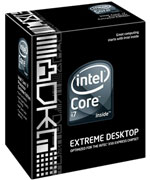 |
The i7 965 is the top of the Intel Core i7 line. It runs at the highest 3.2GHz available in a stock i7 and it is the only Core i7 with an unlocked multiplier. This makes the Core i7 965 an extremely flexible CPU for overclocking. In fairness, top-of-the-line processors rarely give the highest percentage overclocks. However, they perform the best at stock speeds and they are the easiest to overclock should you choose to do that. Components do not need to be pushed as far to reach the higher overclocks, which makes it less likely that peripheral limitations will hold back overall OC performance.
Some will ask why in the world we even think of recommending a $1000 CPU. Our answer would be that this is a dream system and price is not an overriding consideration. We also would be willing to bet that if you were offered a $295 i7 920 or an i7 965 at the same price you would choose the 3.2GHz unlocked 965. If the price is too rich you can always choose the lower priced 920 or 940 in the $295 to $595 price range.
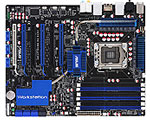 |
The ASUS P6T6 WS Revolution X58 is a workstation board with a very flexible design. It features three x16 PCI-E slots that are truly x16 in operation. That makes the ASUS P6T6 Revolution capable of supporting the fastest triple-SLI setup possible if you are inclined to go in that direction. A dream system should support all the high-end possibilities imaginable and the P6T6 WS will not disappoint. Our motherboard editor, Gary Key, has said he would choose this motherboard for his own personal dream system.
 |
The i7 Dream System needs at least 6GB of triple-channel memory, and there is nothing better on the market right now than the Mushkin 6GB (3x2GB) DDR3-1600 (PC3-12800) 7-8-7-20 kit. The attraction of this Mushkin 6GB package is the aggressive 7-8-7 timings it supports. This memory meets its specs, and it is blazingly fast in a Core i7 system.
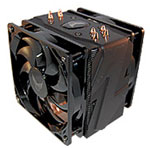 |
Several well-known coolers offer optional adapters for socket 1366, but the cooler choice mated with the ASUS P6T7 WS Revolution is the Vigor Monsoon III LT. Naturally, the Monsoon III LT cools better than the Intel stock cooler and it is a good match to the capabilities of the i7 965 CPU. If you want even better cooling, you will need to go to a large radiator water system or phase-change cooling.
 |
Since a dream system is about best performance, the choice for GPU is the new NVIDIA GTX 295. The hybrid design of the GTX 295 GPUs provides lots of shader horsepower with less RAM and pixel power than the GTX 280. This means the GTX 295 should perform better than two GTX 260 cards in SLI mode, but a bit less than two GTX 280s in SLI. In our game testing the GTX 295 beat the 4870X2 in some games and lost to it in others. Overall, it is certainly the equal of the 4870X2 in performance at about the same $500 price. NVIDIA drivers work very well on the i7 and the GTX 295 will be a fast and reliable performer in the i7 Dream System. A second GTX 295 would even provide quad-SLI if you are looking for bragging rights.
 |
The Silverstone case was a top choice in the Holiday Case and Power Supply Guide. Silverstone's tower uses two large fans in a full aluminum case to create "positive air-pressure". The technique pumps more air inside of the case than fans are exhausting. The positive pressure then pushes the hot air out of every hole in the case. When we changed the direction of the fan from stock, we immediately saw higher temperatures and poorer cooling results, so you might consider a similar approach on your own system. The stock positive pressure design really did cool better in our testing. You can read our full review of the FT01 for more details. The overall quality of the Silverstone FT01 chassis is unmatched today, and those with enough money will not be disappointed. It is not cheap with a price of $210 to $250 without a power supply, but the FT01 remains an exceptional value in a high-end case. The FT01 is a mid-tower case as the best is not always the largest. If you want a larger case than the Silverstone FT01 the Silverstone Full Tower TJ07 series provides the same "positive pressure" design in a full tower case at around $370.
 |
The Corsair 1000W power supply is our choice to power the Core i7 Dream System. The largest power supply that can be driven by a US plug is around 1200W, though EU readers could select even larger power supplies with the higher voltages in use in Europe. However, the Corsair CMPSU-1000HX should handle anything you can install in the Core i7 Dream System. The PSU is SLI Ready, CrossFire Ready, and 80 Plus Certified. This is also a modular design, so it is easy to update power connectors whenever the GPU industry or Intel introduce a new and unique power connector. Corsair has also been very good at keeping up with modular cords when new connectors are introduced.
 |
The ASUS Xonar DX 7.1 is one of the top-performing audio cards on the market today. It is a great upgrade to the onboard sound if you want better sound quality. Game compatibility is excellent, but most game creators assume everyone has a Creative Labs sound card. If your main reason for having a powerful i7 computer is gaming, you may prefer the Creative 7.1 Sound Blaster X-Fi Titanium at the same $90 price. In our opinion, the sound quality is better on the ASUS sound card, but compatibility will never be a question with a Creative Labs sound card.
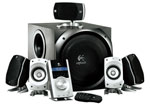 |
In a dream system, one speaker option is a top-of-the-line powered speaker system. That is why speakers have been upgraded to the Logitech Z-5500 550W 5.1 surround sound speakers. At $303 this is certainly not a low-priced option, but it is actually quite cheap compared to option #2, which is regular audio components powering normal audio system speakers. Everyone who has purchased the Z-5500 seems very pleased with the performance, so this was an easy recommendation. That said, some AT Editors have patched their computers into their high-end audio systems, but audio components are a topic for another guide. The Z-5500 delivers great performance for the price and will not likely disappoint you in your dream Core i7 build.
You may need to reread our Holiday 2008 Display Guide to fully appreciate our monitor selection for the Core i7 Dream System. You definitely need a 30" monitor with 2560x1600 resolution to fully utilize the NVIDIA GTX 295 GPU. Fortunately 30" monitors have dropped in price and you can now buy a 30" display for around $1000. On the surface that seems like a good thing, but things are not always what they appear.
The bad thing about the price drop in 30" monitors is that most of the choices have been reworked and now use a TFT display panel. That is OK, but the IPS panel that used to be common in the 30" display is a much better panel. Color fidelity is better and IPS looks much better - especially for photo editing and graphics creation where color accuracy is most important.
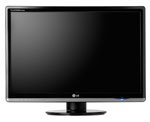 |
Fortunately LG still makes an S-IPS 30" display for just a little more than the typical $1000 TFT 30" display, and the Core i7 Dream System features the 30" LG W3000H-Bn 30" 5ms with the S-IPS Panel at $1100. We don't have the LG IPS panel in house, but we have seen the difference an IPS panel makes in other monitor sizes. Those in the know also report the picture quality of the LG W3000H-Bn is truly stunning, and a fitting match to the Core i7 Dream System.
The dream system deserves an SSD as a boot/game drive but we are in the process of testing the more recent drives to see if the new SATA II SSDs finally correct the corruption and pause issues seen in past testing. In the meantime, if you need a reliable choice for an SSD today we can recommend the Intel X-25M SSDSA2MH160G1C5 160GB. It is very expensive compared to the most recent SSD introductions, but it does deliver performance as promised. As soon as testing of the current crop of SSD drives is complete we will revisit potential SSD recommendations.
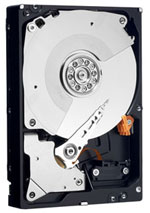 |
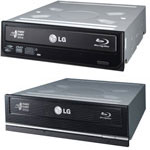 |
The remaining components are similar to the i7 OC choices. The storage hard drive remains 1TB but the Western Digital was chosen for the dream system at a slightly higher price. For optical drives, two Blu-ray drives were chosen for more flexible backup and disc copying. One is the LG Blu-ray reader featured in the Core i7 Entry and the second is the LG Blu-ray writer that was used in the Core i7 OC system. With both a Blu-ray reader and a writer for the 25GB/50GB Blu-ray disks you have a very flexible system for handling Blu-ray, which makes sense in a Dream system.
We also upgraded to Windows Vista Ultimate. Frankly, it adds nothing we need in our dream system that could not be provided by Vista Home Premium, but a dream system deserves Vista Ultimate. Alternately, if you are the self-assured type, use Vista Home Premium and slam your friends who chose Ultimate. Ask them why and then explain why not.
 |
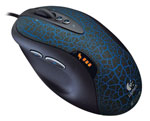 |
The last area to discuss is input devices, where we went with gamer favorites in the Logitech G15 gaming keyboard and the G5 gaming laser mouse. Both are very well regarded devices that fit well with the capabilities and concept of the Core i7 Dream system. If you covet the dream system for graphics and photo editing but not gaming, you can easily drop the G15/G5 and select precision input devices that better fit your needs.
Final Words
The Intel Core i7 processor currently owns the high end of the market, which is the reason the CPU prices remain high relative to Intel Core 2 Quad and the AMD Phenom II. The cheapest Core i7 920 CPU is around $300, with two more models going for $600 and $1000. In addition, the Core i7 uses a new socket 1366 and supports the first triple-channel DDR3 memory configuration. That means new Core i7 buyers will be shopping for a number of new and unique components as they move to Core i7.
Despite the high cost of the CPU and the uniqueness of some components, we have shown that it is possible to build a complete high performance Core i7 system for as little as $1450. That price is for a system with 1TB hard drive, Blu-ray player/DVD burner, a Radeon HD 4870 1GB video card, 1920x1080 monitor, keyboard/mouse, and even Windows Vista Home Premium. If you have some components that are compatible with a Core i7 build, you can reduce the cost even further. Just be sure you will not be leaving performance behind with the components you are considering moving over to a new Core i7 build.
We also showed an extremely flexible Core i7 overclocking system build with components selected to support overclocks to 4.0GHz with the Core i7 920 processor. While the cost was just a bit over $2000 for the complete system, the overclocking i7 system should carry you considerably higher than the current top-line Core i7 965 which runs at 3.2GHz. The OC system was pushed toward value overclocking but the $1010 965 CPU is unlocked and it could be the basis of a "highest performance at any cost" Core i7 overclocking system.
Finally, our Core i7 Dream system used all the best performing parts we could assemble in a $5000 "performance king" system built around a 30" S-IPS panel LCD driven by an NVIDIA GTX 295 dual GPU video card. The Dream Core i7 includes the superb Silverstone "positive pressure" aluminum case and the similarly excellent Corsair 1000HX modular power supply driving a $1010 Core i7 965 and 6GB of fast Mushkin DDR3-1600 triple channel memory. We could have carried the "dream" even further with items like RAID 5 storage, a boot SSD RAID, quad SLI with two GTX 295, or a GTX 285 triple SLI setup - supported by the ASUS motherboard used in the dream system. We went as far as $5000 would take us and paused, but there could definitely be more.
The point of all this is that while the Core i7 CPU is the most expensive processor family in today's CPU market, there are still many options. You can build a complete i7 system for less than $1500, use the Core i7 as the heart of an overclocking computer for around $2000 that has incredible performance potential, or use the top $1000 Core i7 965 as the basis for a luxury system with extreme performance for gaming, photo editing, or graphics. The Core i7 is that flexible and is at home in a wide variety of computer configurations. Of course, if all you do is surf the Internet, write email, and work in Microsoft Office, you should save your money and get a more reasonable system - there are plenty of people that simply have no need for eight logical processing cores.
We hope these three systems with widely different goals and prices have given some ideas of where you might like to take a Core i7 build. Wherever you take it, you will be extremely pleased with the Core i7 performance. Core i7 owns the top of the current CPU market because it delivers the best performance in the market today. There is definitely a price premium but you get the best performance you can buy in today's desktop market with an Intel Core i7 system.
Source : http://www.anandtech.com/guides/



No comments:
Post a Comment